Stories > Changing Landscapes
Changing Landscapes

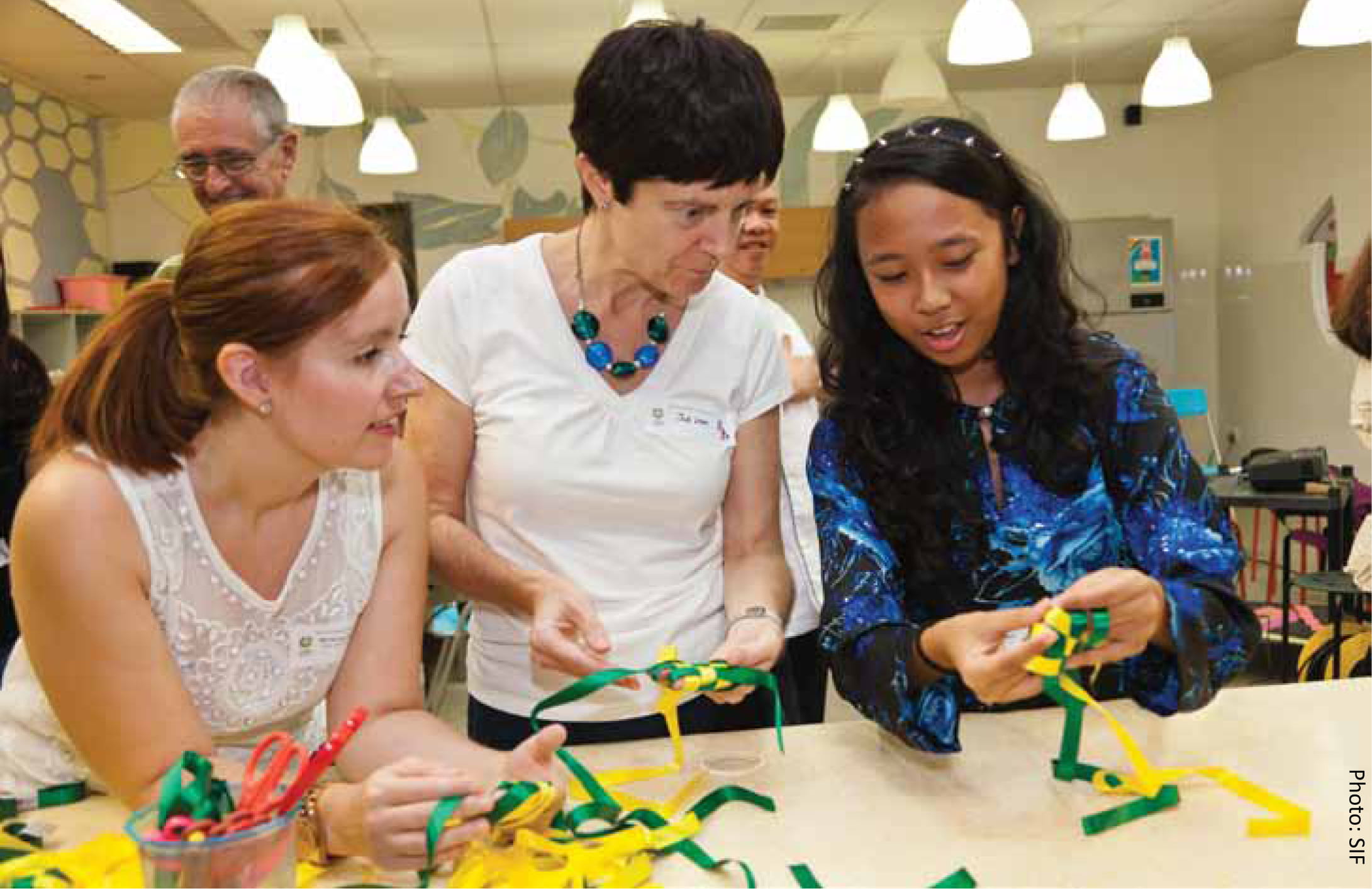
Expatriates from the British community in Singapore learn how to weave ketupat (cases for Malay rice cakes) as part of the Singapore International Foundation’s Little by Little programme.

Many expatriates in Singapore are finding ways to integrate into the new environment they have relocated to. Some send their children to local schools, while others join neighbourhood activities, volunteer in community activities or share their own cultures with the locals.
By Shabnam Muzammil
hile some newcomers to Singapore find organic ways of integrating themselves into the local community, others adapt to the Singaporean way of life with support from organisations. The National Integration Council (NIC) (www.nationalintegrationcouncil.org.sg), a governmental organisation that facilitates social integration between foreigners and locals, is one of them.
Through NIC’s Community Integration Fund, initiatives such as field trips, workshops, seminars on Singapore’s culture and history, and cultural exchange programmes are initiated to encourage expatriates to explore and learn more about Singapore.
The Chinese Development Assistance Council (CDAC), also runs programmes for expatriates to help them better understand local cultures and social norms. The Singapore Indian Development Association (SINDA) has specific programmes to help non-locals integrate into the community.
One example is the Indian Business Leaders’ Roundtable, which provides a platform for members to give back to the community through long-term and short-term programmes.
S Venugopal, Senior Executive for Community Engagement and Volunteer Management at SINDA, has noted an increase in the number of expatriates participating in their programmes over the years. Volunteers offer skills in their areas of expertise, such as IT-related services and other technical skills.
“Many sign up as volunteers on the SINDA website. Some walk in or call to enquire how they can get more involved in the Indian community. Based on their skills sets and interests, we then match them to appropriate programmes,” says Venugopal.
Running Singapore’s Streets
‘Home’ has taken on a whole new meaning for one such expatriate family. Originally from Sri Lanka, the Mohamed Ali family once lived among the cherry blossoms of Japan, trekked the desert sands of the United Arab Emirates, and even ate kimchi every single day for seven years in Korea. Today, Ali and his wife Fazeena Hassan Ali, reside in Singapore.
The Sri Lankans enrolled their children — 11-year old Hanan and seven-year old Hadhiyah — in the local school, Madrasah Al-Irsyad, so they could learn the Malay language.
Ali explains, “We opted for them to learn Malay, as we feel it would give them better access to the Singaporean community, particularly the Malay-Muslim community. It’s a great way for our kids to integrate themselves quickly into the local framework.”
To build ties with locals, the couple joins Singaporeans and other expatriates in various outdoor activities to walk, run and cycle the streets of Singapore. For example, Fazeena, recently participated in the 5km circuit of the Great Eastern Women’s Run 2013. It was her first official run last November. Fazeena felt an immense sense of being part of something big. She says, “There were 15,000 sisters ahead of me and another 15,000 behind me!”
Ali, on the other hand, cycles and runs with pals like Eric Goh, his best Singaporean friend, twice a month. He has taken part in several non-competitive sports events since 2011, citing the North Face Singapore 100 and OCBC Cycle Singapore as the regular ones, apart from others like the Standard Chartered marathon. “These are great networking opportunities for making new friends more easily.”
“We opted for them to learn Malay as we feel it would give them better access to the Singaporean community…”
— Sri Lankan Mohamed Ali, referring to his two children
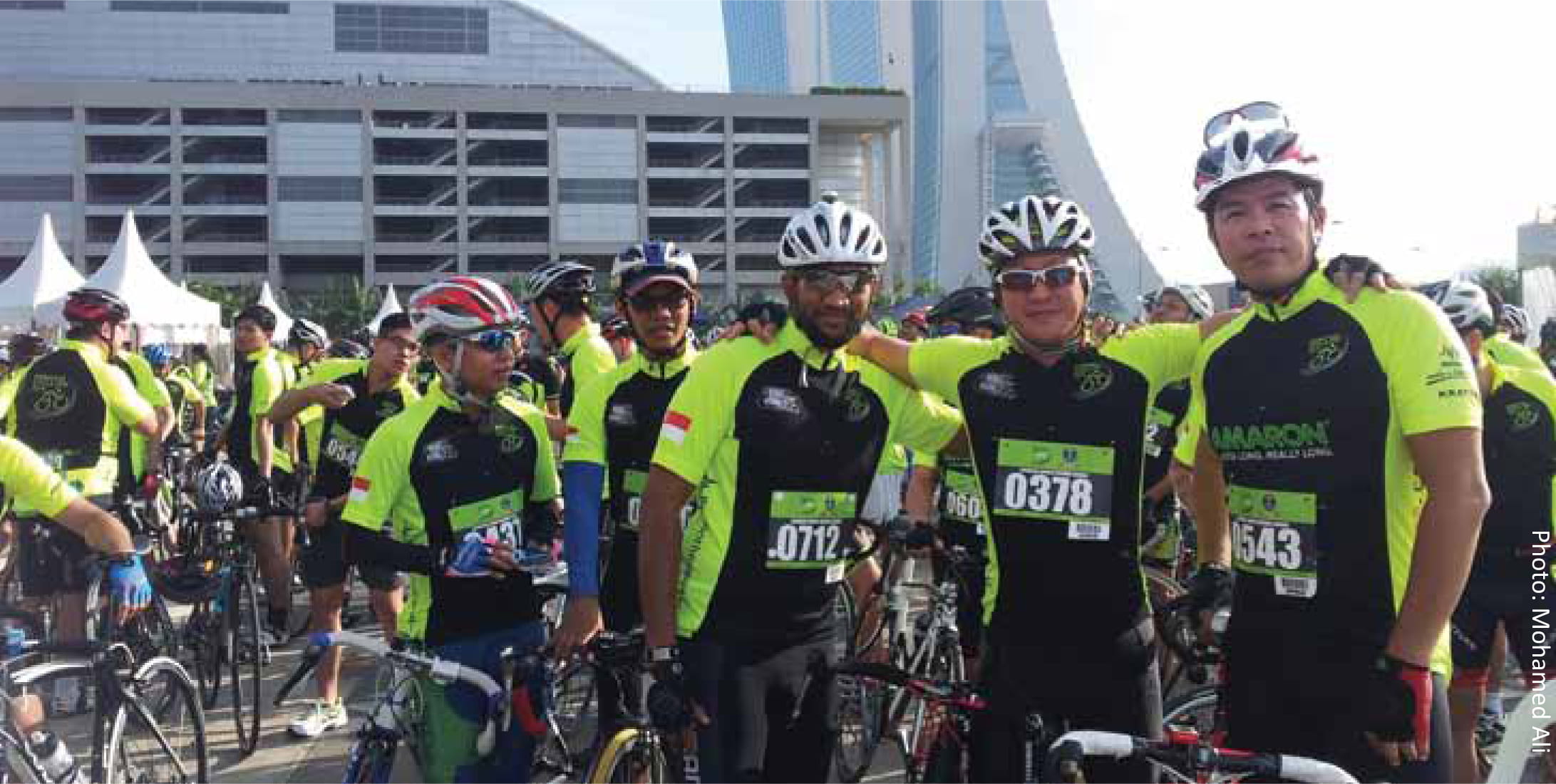
Sri Lankan Mohamed Ali (jersey no. 0712) with his running and biking pals, Singaporeans Eric Goh (jersey no. 0378) and Alex Ng (jersey no. 0543).
Fazeena agrees, “Bonds are formed easily among fellow participants, especially when we share a common goal.”
To stay connected to their social circle, the couple often hosts communal and potluck meals in their three-room Housing Development Board (HDB) apartment. Their group of acquaintances is a mix of Singaporeans, Sri Lankans, Dutch, Germans, Chinese and Malaysians.
“We all need friends,” says Ali. “Wherever we travel, we mix with locals so that we can be part of their community. It’s a good way to cultivate new relationships and be exposed to their views, thoughts and opinions.”
A Little Cross-Cultural Exchange
While some may be watching movies or catching up on sleep on Saturday afternoons, a small group of people is doing something different. These foreign residents in Singapore enjoy sharing their cultures with young Singaporeans, and learning more about Singaporean culture in turn.
They are part of the Singapore International Foundation’s ‘Little by Little’ programme, which aims to foster cultural exchange. Each session typically sees 25 to 30 participants, comprising Singaporean youth from the arts school, Little Arts Academy, together with members of the foreign communities for an an exchange of knowledge and skills, such as dancing, cooking or art.
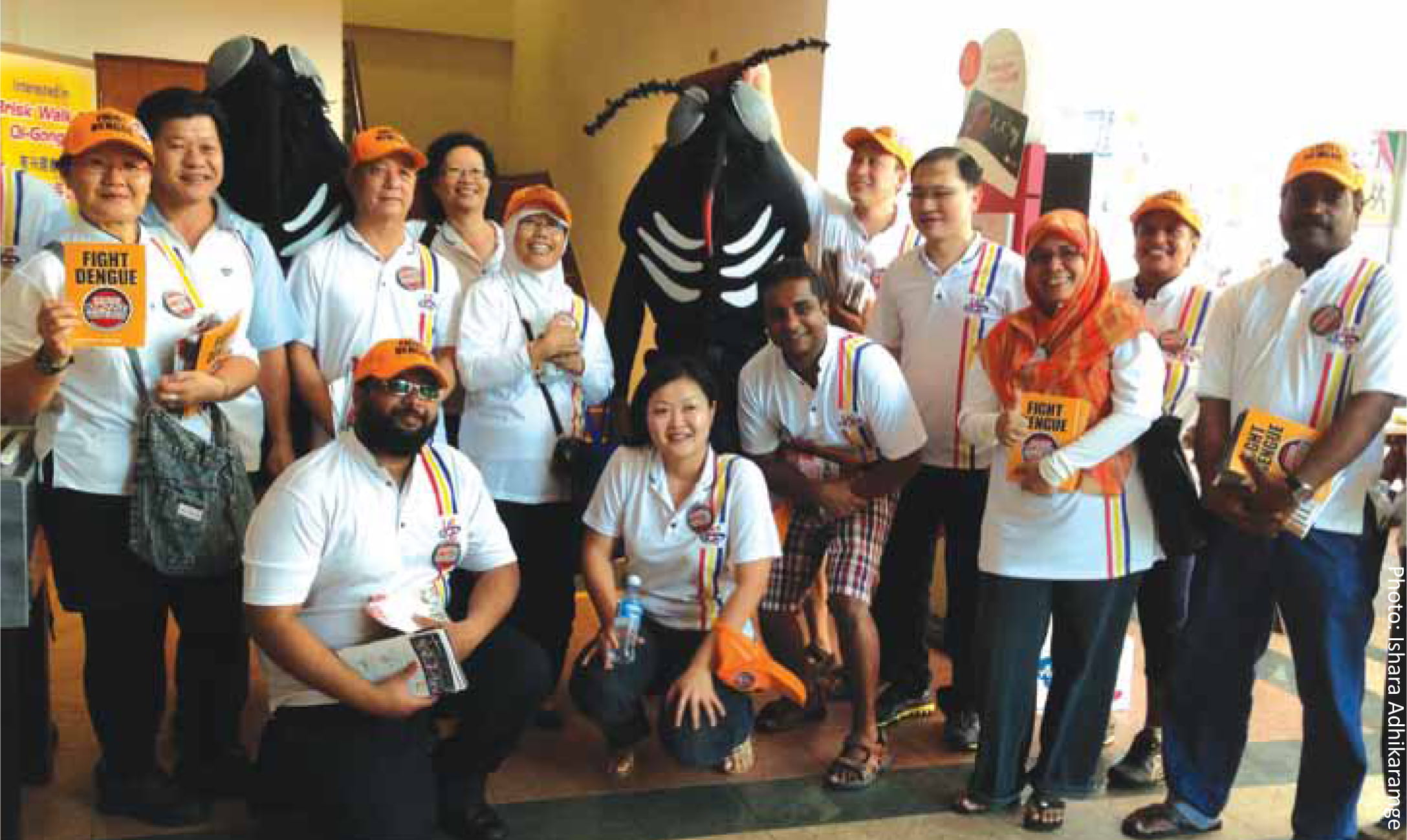
Sri Lankan national Ishara (half-squatting in front of the mascot) joins Bedok Community Centre volunteers to distribute flyers to households in their neighbourhood as part of the Dengue Prevention programme.
In August last year, people from the British Club and the British High Commission shared unique elements of British history and culture, such as the medieval tradition of the town crier, and how to make scones, with the youth. The youth, in turn, gave a presentation about the Muslim festival of Hari Raya Aidilfitri and showed the British how to weave the coconut leaf cases for ketupat (rice cakes).
The programme provides an avenue for gaining insight into each community that wouldn’t come easily otherwise. “You are talking to youth you would probably not be able to connect with in other ways. This is the easiest and most fantastic way,” said Kamsiah Kamaruddin, Deputy High Commissioner, Malaysian High Commission. The Malaysia session in May 2013 taught the youths how to joget (the traditional Malay dance originating in Malacca) and how to make roti jala (lace pancakes often eaten with chicken curry).
For young people who may not have the opportunity to travel, this brings the experience of other cultures to them. Surasak Chinnapongse, President of the Thai Association of Singapore, says of the session held in August 2012, “Today, we made lanterns that are part of the Loy Kathrong lantern festival in mid-November every year and shared the purpose of this festival. We also tried some Thai cultural dancing.”
“So, I looked around for ways to make even the smallest contribution to the community I live in. It makes us feel somehow part of this society that we were not born into.”
— Sri Lankan Ishara Adhikaramge
The ‘Little by Little’ programme has held 17 sessions since its inception in 2011, matching various communities with groups of youth from the Little Arts Academy. These are underprivileged youth aged 13 to 20 who and have been selected for the programme through an application and audition process.
The programme was born as a response to the international community’s request for more ways of engaging with Singaporeans. Says Soh Lai Yee, Deputy Director of International Networking at SIF, “We launched ‘Little by Little’ because we had received feedback from the international community that they wanted to be more plugged into the local community.”
The young people also relish sharing their culture. Says Vishnucharan Naidu, 18, who gave a presentation on Deepavali, “I realised that Singapore is a very small place so it’s not experienced by many people. I feel happy to share about our Singaporean culture because I believe strongly in my culture and tradition.”
Klinnsman Lim, 17, who presented Singaporean Chinese traditions to Chinese visitors from SIF’s Young Business Ambassadors programme says, “What I find most enriching is that it’s not just about learning about new cultures, but accepting these different people from different ethnic groups first before you learn about their cultures.”
Weekends Volunteering
Sri Lankans, Ishara Adhikaramge and Anurangi Singh have been volunteering at the Bedok Community Centre to get to know locals better. “Coming from a different country, we have no emotional ties binding us to this land. So, I looked around for ways to make even the smallest contribution to the community I live in. It makes us feel somehow part of this society that we were not born into,” explains Ishara.
When their schedules permit, they spend their weekends volunteering at their neighbourhood Community Centre in Bedok. They take part in community centre activities that require door-to-door interaction with their neighbours.
The couple soon befriended fellow volunteers, and friendships were forged through joint participation with neighbours that included distributing dry food rations to the elderly and less privileged living around Bedok, handing out leaflets as part of the Dengue Prevention Programme and organising a Movie Night. All these give the expats opportunities to be in the know regarding the goings-on in their community.
“There is mutual goodwill and a special bond formed out of simply doing something as a team”, Ishara explains.
When the Bedok community centre holds celebratory gatherings during festive occasions like Hari Raya Puasa and Deepavali, Ishara and his family get together with their neighbours to share a meal.
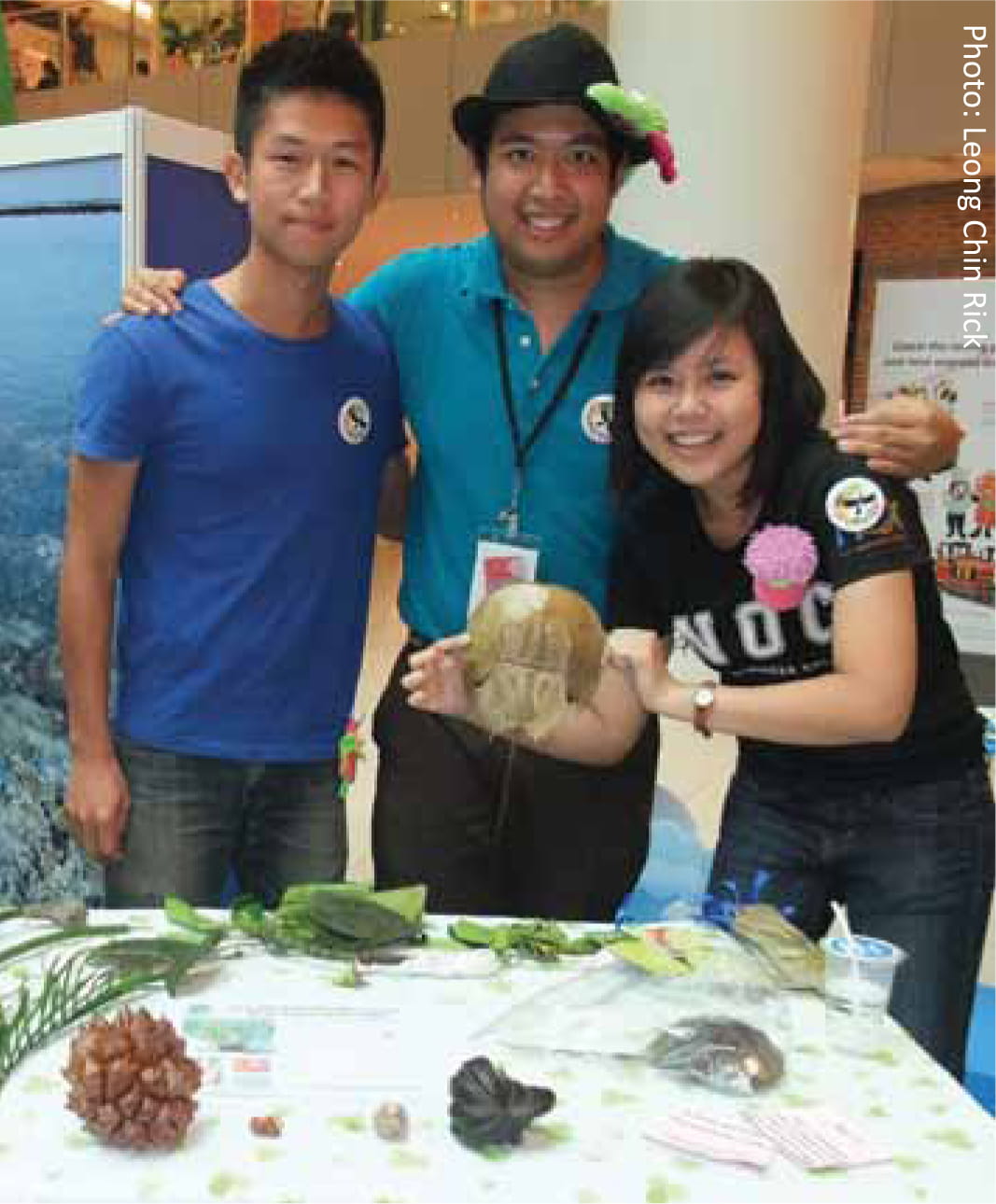
Malaysian Leong Chin Rick (wearing hat) with fellow Mangrove Action Squad members, Lee Wei Kit on his right and Joanna Yeo in black, at his booth on mangroves during the Festival of Biodiversity, where he was involved in operating a mangrove station as part of the Marine exhibition section. The squad helped educate the public about mangroves, from the identification of species that exist there to conservation of this delicate ecosystem.
Tours of Mangroves
Like the Adhikaramges, Malaysian Leong Chin Rick is another expat who ventured into volunteering while he was still a student at the National University of Singapore, in 2011.
In the beginning, Leong faced challenges in making local friends.
He admits, “Back then, my opinion of Singaporeans was that they are more interested in shopping and materialistic pursuits and not the least concerned about nature!”
Environmental biology and nature-related activities, which were his interests, seemed the logical avenue to get started with. He formed a special interest group, ‘The Mangrove Action Squad’ — by educating locals and Singapore residents on mangroves (mangroveactionsquad.wordpress.com/).
Leong conducts free guided tours of mangrove boardwalks and he also volunteers for an annual event called the Festival of Biodiversity. He manages a booth and educates visitors on mangroves in Singapore and the importance of their conservation in the ecosystem.
“I have conducted free guided walks at Pasir Ris Park and a few programmes for local schools too. Most of the participants are local families with young children. I have spent many hours chatting with participants. I believe I’ve helped Singaporeans connect better to nature…. Some of them have changed their perspective on green issues. This is something I’m very proud of and will continue doing.”
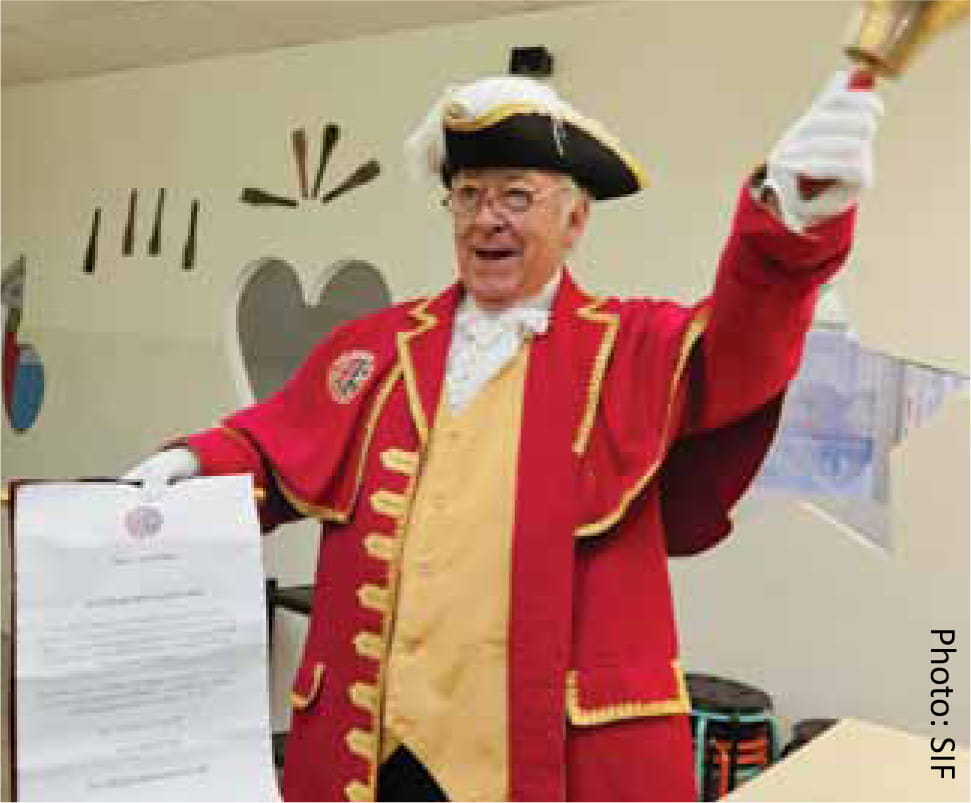
The British community enacts the medieval English tradition of the town crier at a ‘Little by Little’ session by SIF.
